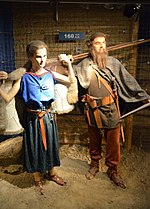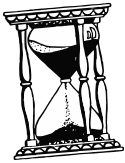Det Vestromerske Riges fald
Det Vestromerske Riges fald (Romerrigets Fald eller Roms Fald) var en proces med nedgang i det Vestromerske rige, hvor man ikke formåede at håndhæve styret og store områder blev delt op i mindre enheder. Romerriget mistede sin styrke, der havde muliggjort effektiv kontrol; moderne historikere nævner faktorer som effektivitet og antallet af soldater, sundhed og den romerske befolkning, økonomiens slagkraft, kejserens kompetencer, religiøse og civiladministrative ændringer. Øget pres fra barbarerne bidrog i høj grad til rigets kollaps. Årsagerne er interessante for historiografien om antikken og emne for mange moderne diskussioner om statsforfald.[1][2]
Vigtige datoer er 117 e.Kr., hvor riget havde sin største udstrækning, og Diocletians kroning 284. Store territoriale tab begyndte i 376, hvor en storstilet invasion af gotere og andre begyndte. Efter at have vundet to ødelæggende borgerkrige i 39 e.Kr., døde Theodosius 1.. Det efterlod en svækket hær og et rige, der stadig var plaget af goter og delt mellem to uduelige sønner. I 476 da Odoaker afsatte kejser Romulus, havde den vestromerske kejser en ubrugelig militær, politisk og finansiel magt uden kontrol over de spredte vestlige områder, som stadig kunne kaldes romerske. De invaderende barbarer havde etableret deres magt i størstedelen af det vestromerske rige. Selvom det stadig eksisterede i flere hundrede år, og dets kulturelle indflydelse stadig ses i dag, fik det Vestromerske Rige aldrig styrken til at rejse sig.
Faldet er ikke bare en historisk afslutning; perioden kaldes senantikken med vægt på den kulturelle kontinuitet under og efter den politiske kollaps.
Referencer
- ^ Ward-Perkins 2007, s. 1.
- ^ f.eks. Why Nations Fail. Acemoglu D and Robinson JA. Profile Books (Random House Inc.) 2012. ISBN 978-1-84668-429-6. pp. 166–175
Litteratur
- Alföldy, Géza. Urban life, inscriptions,and mentality in late antique Rome. In Urban Centers and Rural Contexts in Late Antiquity, Thomas S. Burns and John W. Eadie (eds.). Michigan State University Press 2001. ISBN 0-87013-585-6.
- Ammianus. The History. Trans. J. C. Rolfe. Loeb Classical Library, Vol. I, 1935.
- Bowersock, Glen, Peter Brown, Oleg Grabar. Interpreting Late Antiquity: essays on the postclassical world. Belknap Press of Harvard University Press, 2001. ISBN 0-674-00598-8.
- Brown, Peter. The Making of Late Antiquity, Harvard University Press, 1978.
- Burns, Thomas S. Barbarians Within the Gates of Rome : A Study of Roman Military Policy and the Barbarians, ca. 375–425 A. D. Indiana University Press 1995. ISBN 978-0-253-31288-4.
- Börm, Henning. Westrom. Von Honorius bis Justinian Arkiveret 28. juli 2017 hos Wayback Machine. Kohlhammer 2013. ISBN 978-3-17-023276-1 (Review in English Arkiveret 22. august 2017 hos Wayback Machine).
- Cameron, Averil. The Mediterranean World in Late Antiquity. AD 395–700. Routledge 2011, ISBN 978-0415579612.
- Connolly, Peter. Greece and Rome at War. Revised edition, Greenhill Books, 1998. ISBN 978-1-85367-303-0.
- Gaddis, Michael. There Is No Crime for Those Who Have Christ. Religious violence in the Christian Roman Empire. University of California Press, 2005. ISBN 978-0-520-24104-6.
- Galinsky, Karl. Classical and Modern Interactions (1992) 53–73.
- Gibbon, Edward. History of the Decline and Fall of the Roman Empire Arkiveret 30. august 2017 hos Wayback Machine. With notes by the Rev. H. H. Milman. 1782 (Written), 1845 (Revised)
- Goldsworthy, Adrian. The complete Roman Army. ISBN 978-0-500-05124-5. Thames & Hudson, 2003.
- Goldsworthy, Adrian. The Fall of the West: The Slow Death of the Roman Superpower. ISBN 978-0-7538-2692-8. Phoenix, an imprint of Orion Books Ltd, 2010.
- Heather, Peter. The fall of the Roman Empire. A new history. Pan Books, 2006. ISBN 978-0-330-49136-5.
- Halsall, Guy. Barbarian Migrations and the Roman West, 376–568 (Cambridge Medieval Textbooks)
- Harper, Kyle. Slavery in the late Roman world AD 275–425. ISBN (hardback) 978-0-521-19861-5. Cambridge University Press 2011.
- Hunt, Lynn, Thomas R. Martin, Barbara H. Rosenwein, R. Po-chia Hsia, Bonnie G. Smith. The Making of the West, Peoples and Cultures, Volume A: To 1500. Bedford / St. Martins 2001. ISBN 0-312-18365-8.
- Hodges, Richard, Whitehouse, David. Mohammed, Charlemagne and the Origins of Europe: archaeology and the Pirenne thesis. Cornell University Press, 1983.
- Jones, A. H. M. The Later Roman Empire, 284–602: A Social, Economic, and Administrative Survey [Paperback, vol. 1] ISBN 0-8018-3353-1 Basil Blackwell Ltd. 1964.
- Letki Piotr. The cavalry of Diocletian. Origin, organization, tactics, and weapons. Translated by Pawel Grysztar and Trystan Skupniewicz. Wydawnictwo NapoleonV ISBN 978-83-61324-93-5. Oświęcim 2012.
- Macgeorge, Penny. Late Roman Warlords. Oxford University Press 2002.
- MacMullen, Ramsay. Corruption and the decline of Rome. Yale University Press, 1988. ISBN 0-300-04799-1.
- Martindale, J.R. The Prosopography of the Later Roman Empire volume II, A.D. 395–527. Cambridge University Press 1980.
- Matthews, John. The Roman empire of Ammianus. Michigan Classical Press, 2007. ISBN 978-0-9799713-2-7.
- Matthews, John. Western aristocracies and Imperial court AD 364–425. Oxford University Press 1975. ISBN 0-19-814817-8.
- Momigliano, Arnaldo. 1973. "La caduta senza rumore di un impero nel 476 d.C." ("The noiseless fall of an empire in 476 AD"). Rivista storica italiana, 85 (1973), 5–21.
- Nicasie, M. J. Twilight of Empire. The Roman Army from the reign of Diocletian to the Battle of Adrianople. J. C. Gieben, 1998. ISBN 90-5063-448-6.
- Randsborg, Klavs. The First Millennium AD in Europe and the Mediterranean: an archaeological essay. Cambridge University Press 1991. ISBN 0 521 38401 X.
- Rathbone, Dominic. "Earnings and Costs. Part IV, chapter 15", pages 299–326. In: Quantifying the Roman Economy. Methods and Problems. Alan Bowman and Andrew Wilson eds. Oxford University Press 2009, paperback edition 2013, ISBN 978-0-19-967929-4.
- Ward-Perkins Bryan. The fall of Rome and the end of civilization. Oxford University Press 2005 (hardback edition). ISBN 978-0-19-280728-1
| |||||||||||||||||||||||||||||||||||||
| Spire Denne historieartikel er en spire som bør udbygges. Du er velkommen til at hjælpe Wikipedia ved at udvide den. |
|
Medier brugt på denne side
Forfatter/Opretter: Silar, Licens: CC BY-SA 3.0
Man and women of fine, slender build, long narrow heads and fine features. The women wears a blue line shirts without sleeves, red-trimmed at neck and shoulder edges and fastened together in front with bronze pin and on the shoulders with silver-inlaid iron pins. Long green checered skirt , tied at the wast with a leather thong. Leather belt with the iron buckle, a knife hanging from it in a leather sheath , along with a clay whorm and iron key; spindle with a decorated clay whorl stuck in the belt. Melon-sheped bead of green grass hung around the neck. Sheep's fleece over the shoulders. Hair in thin braids arranged in a bun. Openwork leather shoes tied with thong aboves the ankle. The man's dress consists of a brown woolen shirt, long trousers of fulled wool gathered at the waist into a belt with beltv carries and kept in place with string. Short fringed cape over the shoulders, fastened with a silver brooch on of the shoulder blades. Shirt with wide leather belt fitted with an iron openwork buckle and bronze rivets, also an iron ferrule with ring. Hung at the waist : archer scissors of iron, knife in leather sheath , mounted on a leather belt colled a balteus with bronze-coverd iron tip. Harpoon and iron-headed spear in the hand, a wooden shield with iron umbo and handle in the left.Hair pulled up in a 'Swebian knot'. [Prehistory and early middle ages of Lesser Poland, Guide, Archaeological Museum in Cracow, 2006, ISBN 978-83-911543-7-3 p. 33, January 2024
Forfatter/Opretter: Roke (d), Licens: CC BY-SA 3.0
Animated map of the Roman Republic and Empire. Displayed in the map:




